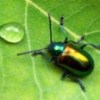Asphinctopone differens Bolton & Fisher 2008
A new species from the Central African Republic
Bolton & Fisher Revise Asphinctopone (Zootaxa)
Shattuck Revises the Indo-Pacific Prionopelta
All imported Fire Ants in the U.S. are descended from 9-20 initial foundress queens
[summary in ScienceDaily]
ZooKeys: A new open-access journal for biodiversity & taxonomy

